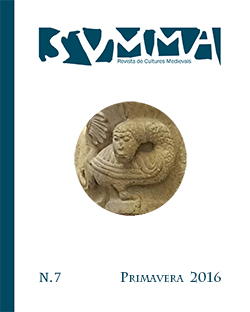«Ni lla pora nuza baisar»: Physical Love and Love Conversations in the Illustrated Manuscript of the Roman de Jaufre (Paris, BNF, fr. 2164)
DOI:
https://doi.org/10.1344/Svmma2016.7.6Palabras clave:
Love, senses, illuminated manuscripts, Middle Ages, Roman de Jaufre, Occitan language, King of Aragon, Aljafería, ZaragozaResumen
The illustrated manuscript of the Roman de Jaufre is not as simple and naïf as we may think. It is well organized, with approximately 250 illustrated scenes for only 110 folios. The images are always close to the part of the text they illustrate. In the first part of the manuscript we see mainly fighting and chivalrous adventures, with a very realistic, crude, and vivid style. In the second part, after the change of scribe, we see more courtly scenes, with the banquets and the joy of the court for the marriage between the two main characters. On the first folio a winged cupid is shooting an arrow, and the only inhabited initial of the manuscript depicts woman, maybe Brunissen, at the moment of the engagement. In contrast, the image of the marriage looks more like a coronation scene. We know that the roman was dedicated to a king of Aragon; we also know, from codicological, stylistic, and textual evidence, that the manuscript is dated around the second half of the thirteenth century. Therefore, I propose to search for the original context of production the cultured milieu that surrounded the court of Peter the Great of Aragon and Constance of Sicily.Descargas
Publicado
Número
Sección
Licencia
Derechos de autor 2016 Anna Lisa Vitolo

Esta obra está bajo una licencia internacional Creative Commons Atribución-NoComercial-SinDerivadas 4.0.
Los autores que publican en esta revista están de acuerdo con los siguientes términos:
a. Los autores conservan los derechos de autoría y otorgan a la revista el derecho de primera publicación de la obra. SVMMA Revista de Culturas Medievales publica con una licencia de Reconocimiento-NoComercial-CompartirIgual 3.0 España de Creative Commons, la cual permite compartir la obra con terceros, siempre que éstos reconozcan su autoría, sin ánimo de lucro y compartan la obra derivada en las mismas condiciones.
b. Los autores son libres de hacer acuerdos contractuales adicionales independientes para la distribución no exclusiva de la versión de la obra publicada en la revista (como la publicación en un repositorio institucional o en un libro), siempre que se reconozca su publicación inicial en esta revista.
c. Se anima a los autores a publicar su obra en línea (en repositorios institucionales o en su página web, por ejemplo), con el objetivo de conseguir intercambios productivos y hacer que la obra obtenga más citaciones (véase The Effect of Open Access, en inglés).





